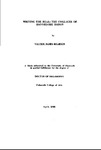WRITING THE REAL: THE COLLAGES OF HANNELORE BARON
| dc.contributor.author | JAMES REARDON, VALERIE | |
| dc.contributor.other | Faculty of Arts, Humanities and Business | en_US |
| dc.date.accessioned | 2013-11-21T14:31:52Z | |
| dc.date.available | 2013-11-21T14:31:52Z | |
| dc.date.issued | 2000 | |
| dc.identifier | NOT AVAILABLE | en_US |
| dc.identifier.uri | http://hdl.handle.net/10026.1/2808 | |
| dc.description.abstract |
Baron's work has not been extensively studied nor is it known in full. Critical writings and scholarly attention have focused on the work as representative of Holocaust suffering. This thesis intervenes in that assumption by arguing that it is possible to understand Baron's processes of making collage as a significant case study in the problematic of signification and a complex of differences none of which are reducible to or deducible from each other. Drawing together a range of biographical information, primary source material and close readings of many of Baron's collages (including two hitherto unseen series) traces are revealed of both a maker, an artistic subject finding itself in its own practice, and a making, in the sense of a process that cannot be bound into the singularity of the subject who made it. A framework is established using psychoanalytic theory and second generation Holocaust theory that allows for the possibility of reading into Baron's life story both the symptoms of unresolved conflicts and a particular set of strategies that enabled her to sustain a creative subjectivity. Kristeva's formulation of art as an imaginaire du pardon permits a reading, however tentative, of Baron's art in terms of a poetics of imaginary restoration and reparation in which archaic and traumatic-affects are given the structure of symbolic representation. This is especially pertinent to Baron's fourteen year experience of cancer. Finally, a consideration of Baron's collage making as a process of inscription that is in relation to the body as a coalition of history, memory, corporeality and the psyche is not only significant to contemporary understandings of identity and subjectivity, but also makes it possible to propose an ethical dimension concerned with a feminine understanding of difference. | en_US |
| dc.language.iso | en | en_US |
| dc.publisher | University of Plymouth | en_US |
| dc.title | WRITING THE REAL: THE COLLAGES OF HANNELORE BARON | en_US |
| dc.type | Thesis | |
| plymouth.version | Full version | en_US |
| dc.identifier.doi | http://dx.doi.org/10.24382/3592 |
Files in this item
This item appears in the following Collection(s)
-
01 Research Theses Main Collection
Research Theses Main


